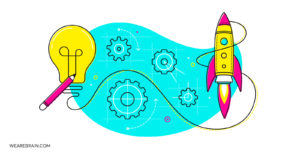AI fatigue: The cause and the cure

Artificial intelligence (AI) has permeated every aspect of our lives. From the moment we wake up to personalised news feeds to the chatbots handling customer service inquiries, AI is undeniably present. But what happens when the constant influx of information, tools, and updates about this revolutionary technology begins to annoy rather than inspire?
AI fatigue is quickly becoming a real phenomenon affecting users, employees, and businesses alike. The initial excitement of exploring AI’s potential can be overshadowed by information overload and a sense that it might replace human skills altogether.
If you’re experiencing AI fatigue, here’s a guide to understanding and overcoming it.
What is AI fatigue?
AI fatigue refers to the weariness, disillusionment, and sense of exhaustion experienced by users and organisations from the constant torrent of information, discussions, and advancements related to artificial intelligence (AI).
This phenomenon arises from the overwhelming abundance of AI tools and news saturating the market, leading to a feeling of being inundated and overwhelmed. For example, how long does it take you to choose what to watch on Netflix? If you had fewer options, your decision would be far easier and quicker.
For both people and businesses, AI fatigue commonly manifests as a reluctance to engage with AI technologies, a diminished enthusiasm for exploring new AI solutions, and a sense of scepticism regarding the transformative potential of AI. Studies show that in 2016, employees were 74% more likely to embrace changes as a result of AI’s impact – today, this number has shrunk to 43%.
This reduction in adoption stems from the perception that AI is being touted as a one-size-fits-all solution to all problems, overlooking the complexities and nuances of the real world.
What is causing AI fatigue?
There are multiple reasons behind the causes of AI fatigue in both users and businesses. Understanding them is the first step in addressing and overcoming them. Let’s explore some key contributors:
Information overload
News articles, blogs, and marketing materials bombard us with the latest AI advancements. This constant barrage can be overwhelming, making it difficult to distinguish between genuine breakthroughs and fleeting trends. The excitement of discovery gets lost in the sheer volume of information.
Unrealistic expectations
AI is often portrayed as the ultimate solution, a one-size-fits-all answer to every business challenge. This perspective overshadows the crucial role of human empathy, creativity, and nuanced understanding in achieving optimal results. Often, new adopters of AI think if they throw money at the problem then AI will miraculously fix problems, which is never the case without proper understanding and organisation-wide buy-in.
Complexity and uncertainty
AI technologies are largely complex, and their implications can be difficult to grasp fully. This complexity, coupled with the rapid pace of technological advancements, can leave individuals and business teams feeling uncertain and apprehensive about the future implications of AI.
Lack of clarity
In some cases, there may be a lack of clarity regarding the practical applications and benefits of AI within specific contexts. Without a clear understanding of how AI can address tangible challenges and drive value, businesses may struggle to see its relevance and become disengaged.
Ethical concerns
The ethical implications of AI, such as bias in algorithms, data privacy issues, job displacement, and most importantly, the AI control problem, can raise significant concerns and contribute to fatigue. These ethical dilemmas can lead to a reluctance to fully embrace AI technologies.
Resistance to change
Some individuals may resist the adoption of AI due to fear of job displacement, loss of autonomy, or changes in workflow. This resistance to change can create barriers to AI adoption and exacerbate feelings of fatigue.
Overemphasis on technology
When AI initiatives prioritise technology over human-centric considerations, such as empathy, creativity, and intuition, it can lead to a sense of alienation and detachment. This overreliance on technology can contribute to feelings of fatigue and disengagement among employees.
Overcoming AI fatigue
Learning to overcome fatigue is crucial to fostering a culture of innovation and adaptability within your business, enabling you to leverage the full potential of AI technologies. By transcending AI fatigue, individuals and businesses can harness AI to drive efficiency, productivity, and competitive advantage.
Here are some actionable steps you can take to overcome AI fatigue:
Acceptance is key
Acknowledge that AI is here to stay. It’s a powerful tool with immense potential. Accepting this reality allows you to approach AI solutions with an open mind and a focus on how they can benefit you.
Embrace education
Dedicate time to learning about AI at a comfortable pace. Start with basic concepts and gradually delve deeper into areas relevant to your work. Utilise online resources, workshops, or even short courses to get yourself informed about the transformative power of AI. Be sure to read our e-book Working Machines: An Executive’s Guide to AI and Automation to learn more about how AI can grow your business.
Demystifying through engagement
Don’t shy away from interacting with AI tools. By experimenting with AI-powered applications related to your field, you’ll gain a firsthand understanding of their capabilities and limitations. This practical experience can help demystify AI and alleviate fatigue.
The human and machine partnership
Let’s not forget the human element. AI thrives on data, but it cannot replicate human creativity, empathy, and critical thinking. The future lies in leveraging AI’s efficiency and precision alongside human expertise. This synergy fosters a more effective and holistic approach to problem-solving.
Time to get energised with AI
AI fatigue is a real challenge, but it doesn’t need to be a roadblock. By adopting a clear-headed approach, prioritising human-centric values, and embracing continuous learning, you can turn AI fatigue into a springboard for innovation.
Finding the right AI solution for you
As digital transformation and business intelligence specialists, we believe in harnessing the power of AI strategically. To avoid AI fatigue, we recommend a human-centric approach that prioritises transparency, explainability, and ethical considerations.
Here’s a shift in thinking:
Instead of chasing the latest AI tool as a solution, begin by clearly defining the problem you’re trying to solve. What are your specific business goals? Understanding your needs is paramount in identifying the AI solution that best complements your existing human expertise.
With so many solutions out there, finding the perfect fit can feel daunting. Don’t be fooled by flashy marketing – focus on transparency and ethics. Choose providers who can explain how their AI works, not just what it does.
Remember, AI isn’t magic. There’s no one-size-fits-all solution. Identify your specific needs, whether it’s for your business or personal use then leverage trusted sources and research to find an AI that aligns with your goals.
Ready to embark on your journey with AI?
At WeAreBrain, we’re passionate about empowering businesses to unlock the potential of AI responsibly and strategically. Contact us today and let’s explore how AI can revolutionise your business landscape.
David Roman
Working Machines
An executive’s guide to AI and Intelligent Automation. Working Machines takes a look at how the renewed vigour for the development of Artificial Intelligence and Intelligent Automation technology has begun to change how businesses operate.







